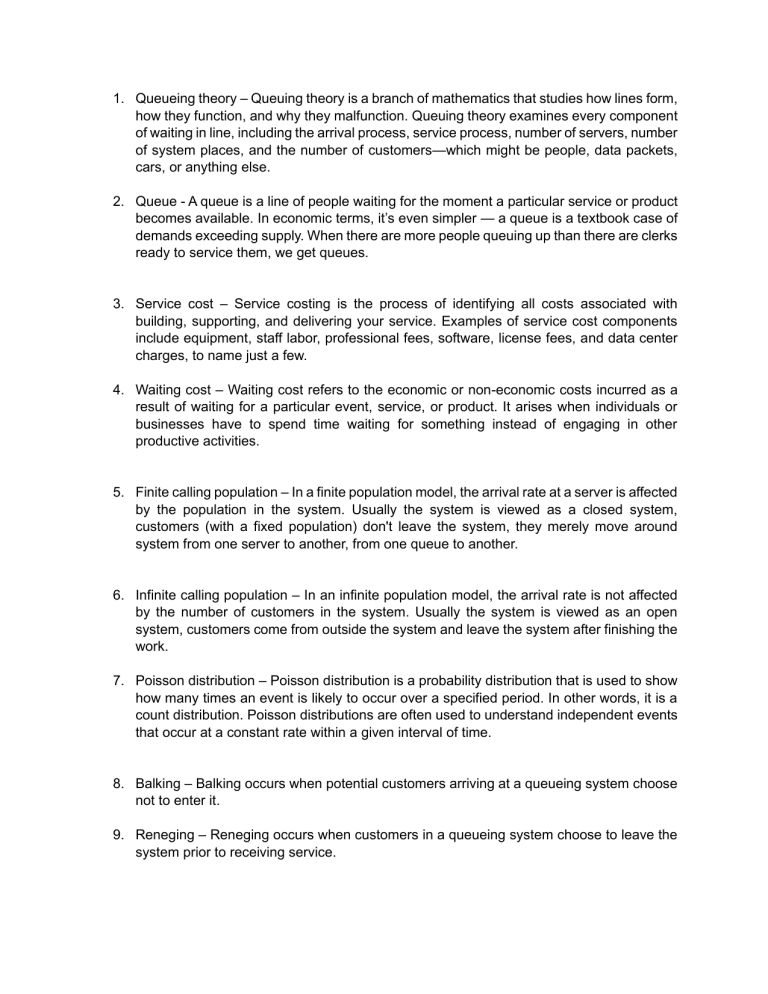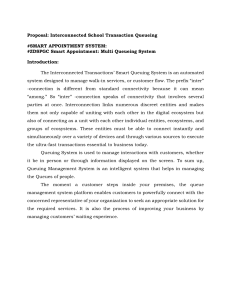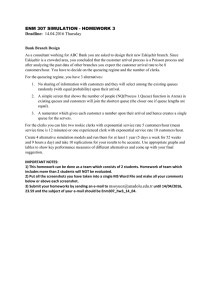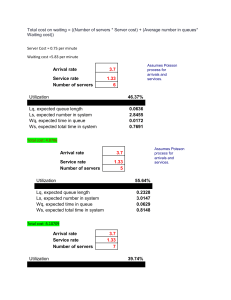
1. Queueing theory – Queuing theory is a branch of mathematics that studies how lines form, how they function, and why they malfunction. Queuing theory examines every component of waiting in line, including the arrival process, service process, number of servers, number of system places, and the number of customers—which might be people, data packets, cars, or anything else. 2. Queue - A queue is a line of people waiting for the moment a particular service or product becomes available. In economic terms, it’s even simpler — a queue is a textbook case of demands exceeding supply. When there are more people queuing up than there are clerks ready to service them, we get queues. 3. Service cost – Service costing is the process of identifying all costs associated with building, supporting, and delivering your service. Examples of service cost components include equipment, staff labor, professional fees, software, license fees, and data center charges, to name just a few. 4. Waiting cost – Waiting cost refers to the economic or non-economic costs incurred as a result of waiting for a particular event, service, or product. It arises when individuals or businesses have to spend time waiting for something instead of engaging in other productive activities. 5. Finite calling population – In a finite population model, the arrival rate at a server is affected by the population in the system. Usually the system is viewed as a closed system, customers (with a fixed population) don't leave the system, they merely move around system from one server to another, from one queue to another. 6. Infinite calling population – In an infinite population model, the arrival rate is not affected by the number of customers in the system. Usually the system is viewed as an open system, customers come from outside the system and leave the system after finishing the work. 7. Poisson distribution – Poisson distribution is a probability distribution that is used to show how many times an event is likely to occur over a specified period. In other words, it is a count distribution. Poisson distributions are often used to understand independent events that occur at a constant rate within a given interval of time. 8. Balking – Balking occurs when potential customers arriving at a queueing system choose not to enter it. 9. Reneging – Reneging occurs when customers in a queueing system choose to leave the system prior to receiving service. 10. Limited queue length – the length of the queue may be limited by the physical area in which the queue forms; space may permit only a limited number of customers to enter the queue. 11. Unlimited queue length – it is assumed that every person who comes joins the line. There is no restriction on the number of people who are actually waiting or there is no restriction on the length of the queue. 12. Queue discipline – Refers to the order in which members of the queue are selected for service. Usually, first-come-first-serve is normally used. 13. FIFO – First In, First Out, commonly known as FIFO, is an asset-management and valuation method in which assets produced or acquired first are sold, used, or disposed of first. For tax purposes, FIFO assumes that assets with the oldest costs are included in the income statement's cost of goods sold (COGS). The remaining inventory assets are matched to the assets that are most recently purchased or produced. 14. Single channel system – Single channel refers to a producer or retailer’s effort to reach customers through only one distribution option, regardless of whether it’s online, catalogue, mail-order, face-to-face selling or traditional retail. This approach reduces marketing investments and organizational complexity. However, the risk with this approach is missed selling opportunities as customers shop alternative channels. This is particularly risky, given how connected and empowered consumers are in the digital age. 15. Multiple channel system – Multi-channel refers to a producer or retailer’s effort to combine and blend different distribution channels to accommodate where and how consumers make purchases, ensuring that producers and retailers will be present when the purchase decision is made. The objective is to make it easy for a consumer to buy in whatever way is most appropriate for them. Multi-channel marketing allows the firm to reach its prospective or current customers at the point of purchase in a channel of their liking. Most firms with which you interact are engaged in multi-channel marketing, if not omni-channel marketing. 16. Single phase system – the customers is served from only one server and then exits the system. 17. Multiple phase system – the customer is served from several servers before exiting. 18. Negative exponential probability distribution – The negative exponential distribution is used routinely as a survival distribution, describing the lifetime of a piece of equipment, etc., put in service at what may be termed time zero. As such, it exhibits a lack of memory property, which may not be desirable in this context. 19. Kendall notation – Kendall’s notation is used for parallel server systems. The basic format of this notation is of form: A / B / c / N / K, where, A, B, c, N, K respectively indicate arrival pattern, service pattern, number of servers, system capacity, and Calling population. The symbols used for the probability distribution for inter arrival time, and service time are, D for deterministic, M for exponential (or Markov) and Ek for Erlang. 20. Steady state – The steady state of a queuing system is the state where the probability of the number of customers in the system is independent of time. 21. Transient state – The transient state of a queuing system is the state where the probability of the number of customers in the system depends upon time. 22. Little’s flow equation – Little’s Law is a mathematical theorem in queueing theory that determines the average number of items in a stationary queuing system. The Little’s Law formula is frequently used in business development and project management systems such as kanban (a popular visual system used to keep track of project activity) to improve workflow and avoid bottlenecks. You can also use Little’s Law in any situation wherever there’s a queue, whether it’s the number of people in line at the grocery store or tasks executed by software. 23. Utilization factor – The utilization factor or use factor is the ratio of the time that a piece of equipment is in use to the total time that it could be in use. It is often averaged over time in the definition such that the ratio becomes the amount of energy used divided by the maximum possible to be used. 24. Multichannel queuing system – Multichannel queuing systems mean when there is more than one counter to serve the same service to a different customer. 25. Operating characteristics – The operating characteristic (OC) curve depicts the discriminatory power of an acceptance sampling plan. The OC curve plots the probabilities of accepting a lot versus the fraction defective. When the OC curve is plotted, the sampling risks are obvious. ANSWERS FROM CHATGPT: 1. Queueing Theory: Queueing theory is a branch of mathematics that studies the behavior and characteristics of waiting lines or queues. It provides mathematical models and analysis techniques to understand and optimize the performance of systems involving waiting lines, such as customer service centers, call centers, transportation systems, and manufacturing processes. 2. Queue: A queue, in the context of queueing theory, refers to a waiting line where entities (such as customers, jobs, or tasks) wait for service or processing. It represents the sequence in which entities arrive and are served. 3. Service cost: Service cost refers to the cost associated with providing a service to customers or processing entities in a queue. It includes expenses such as labor costs, equipment costs, maintenance costs, and other operational expenses incurred to deliver the service. 4. Waiting cost: Waiting cost, as explained earlier, refers to the economic or noneconomic costs incurred when individuals or businesses have to spend time waiting for a particular event, service, or product. It encompasses the opportunity cost of the time spent waiting and can also include subjective costs such as frustration or dissatisfaction. 5. Finite calling population: In queueing theory, a finite calling population refers to a situation where the number of potential entities (e.g., customers) that can join the queue is limited and known in advance. The size of the population is predetermined and does not change over time. 6. Infinite calling population: An infinite calling population, on the other hand, assumes an unlimited number of potential entities that can join the queue. In this case, the population size is so large that it is considered infinite for practical purposes. 7. Poisson distribution: The Poisson distribution is a probability distribution that is often used to model the arrival rate of entities in a queueing system. It is characterized by the assumption of events occurring randomly and independently over time, with a constant average rate. 8. Balking: Balking refers to a behavior exhibited by entities in a queueing system, where they choose not to enter the queue and decide to leave without receiving service. Customers may balk if they perceive the waiting time or service conditions as unfavorable. 9. Reneging: Reneging is another behavior observed in queueing systems, where entities join the queue but leave before receiving service. Customers may renege if they become impatient or if the waiting time exceeds their tolerance. 10. Limited queue length: A limited queue length implies that the queue has a maximum capacity or a predefined limit on the number of entities it can accommodate. Once the queue reaches its maximum capacity, incoming entities are denied entry or redirected elsewhere. 11. Unlimited queue length: In contrast, an unlimited queue length means there is no maximum capacity, and the queue can potentially accommodate an infinite number of entities. This implies that no incoming entity is denied entry due to queue capacity constraints. 12. Queue discipline: Queue discipline refers to the rules or algorithms used to determine the order in which entities are served from the queue. It establishes the fairness and orderliness of the queueing system. 13. FIFO: FIFO stands for "First-In, First-Out" and is a common queue discipline. In a FIFO queue, the entity that arrives first is served first, and the order of service follows the chronological order of arrival. 14. Single channel system: A single channel system refers to a queueing system that has only one service facility or server available to process entities in the queue. The entities are served one at a time. 15. Multiple channel system: A multiple channel system, also known as a multi-server system, has more than one service facility or server available to process entities in the queue. It allows simultaneous service of multiple entities, reducing overall waiting times. 16. Single phase system: In a single phase system, entities require only one stage of service or processing before they exit the queueing system. 17. Multiple phase system: A multiple phase system involves entities that require multiple stages or phases of service or processing before they leave the queue. Each phase represents a different step or activity in the overall service process. 18. Negative exponential probability distribution: The negative exponential probability distribution is commonly used to model the inter-arrival times or service times in queueing systems. It assumes that the probability of an event occurring within a given time interval is exponentially distributed. 19. Kendall notation: Kendall notation is a standardized notation system used to describe and represent queueing systems. It uses a three-part notation that includes symbols for the arrival process, service process, and number of service facilities or servers. 20. Steady state: The steady state refers to the condition where the queueing system has reached a stable equilibrium over time. In this state, the system's performance measures, such as average waiting time and utilization, remain relatively constant. 21. Transient state: The transient state refers to the initial period when a queueing system is not yet in a steady state. It represents the transitional phase where the system's performance measures are changing as it approaches the steady state. 22. Little's flow equation: Little's flow equation, also known as the fundamental equation of queueing theory, states that the long-term average number of entities in a queueing system (L) is equal to the product of the average arrival rate (λ) and the average time spent in the system (W). 23. Utilization factor: The utilization factor, also known as the traffic intensity or system utilization, represents the ratio of the average service rate (μ) to the average arrival rate (λ) in a queueing system. It indicates the level of resource utilization and can help determine the system's performance. 24. Multichannel queuing system: A multichannel queuing system refers to a system that has multiple service facilities or channels available for processing entities in the queue. It allows for parallel processing of entities, reducing waiting times and increasing system capacity. 25. Operating characteristics: Operating characteristics refer to the performance measures used to evaluate the efficiency and effectiveness of a queueing system. Common operating characteristics include average waiting time, average queue length, system throughput, and resource utilization.



